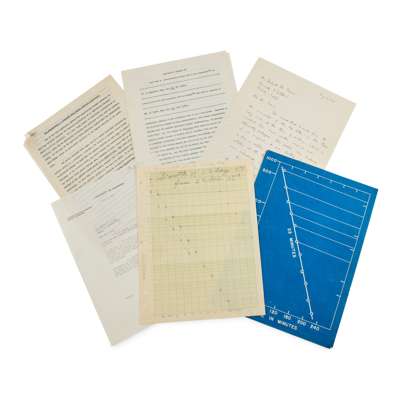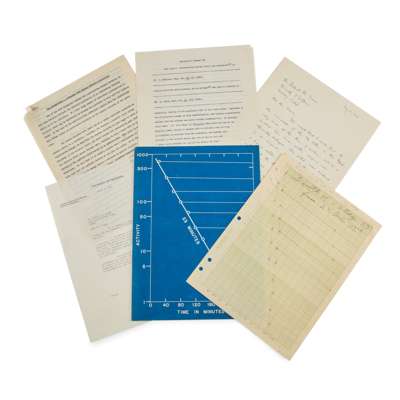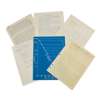
Lot 232

McMillan, Edwin (1907-1991), and Philip Abelson (1913-2004)
Collection of original material relating to the discovery of Neptunium






Rare Books, Manuscripts, Maps & Photographs
Auction: 19 June 2024 from 10:00 BST
Description
‘Radioactive Element 93’, typescript (possibly carbon) of the article published in Physical Review (57, 1185, 15 June 1940) announcing the discovery of Neptunium, 4 ff.;
‘Growth of 2.3 day 93 from 23 min. U293/92’, manuscript graph by Philip Abelson showing the decay of Uranium 293 into Neptunium, in pencil on green graph paper, 28 x 21.5cm, with added pencil caption by Edwin McMillan at head, hole-punched in left-hand margin, the graph published as the figure to the above article;
A printed version of the graph, possibly a cyanotype, 29.7 x 22cm;
‘The Synchrotron - A Proposed High Energy Particle Accelerator’, carbon typescript, 4 ff., stapled at upper left corner;
Autograph letter signed from Edwin McMillan to Dr Herbert McLean Evans (1882-1871) of the University of California, endocrinologist and co-discoverer of Vitamin E, 16 May 1946, ‘Dear Dr Evans, The nearest that I could find to the manuscript of the Np letter is the typed copy made at the time of writing, which is enclosed. The hand-written original was apparently destroyed. The graph also enclosed is an original; it was plotted by Abelson, and has a caption in his hand, and a notation at the top in mine. This graph was reproduced in the published letter. Finally, I am sending a typed copy of the Synchrotron MS; here again the original was destroyed' 1 p., signed ‘Edwin M. McMillan’;
Typed letter signed from Daniel M. Wilkes (assistant to Edwin McMillan at the Lawrence Radiation Laboratory) to Evans, 1963, requesting ‘perusal and possible duplication of the materials he has given you’ on ‘certain materials relating to the discovery of element 93’ (quantity)
Provenance
1) Given by Edwin McMillan to Dr Herbert M. Evans in 1946; 2) With John Howell, bookseller, San Francisco, in 1974; 3) Private collection, Scotland.
Footnote
Edwin McMillan and Philip Abelson's discovery of neptunium, the first transuranium element to be identified, was one of the major advances in chemistry and nuclear physics achieved in the 20th century, initiating a cascade of similar discoveries and securing McMillan the 1951 Nobel prize in the first discipline, which he shared with his Berkeley colleague Glenn Seaborg. The pair made the discovery at Berkeley's cyclotron by subjecting uranium 238 to slow neutron bombardment and detecting a substance with a beta-decay half-life of 2.3 days, differing from the known 23-minute half-life of uranium-239 and consequently attributable instead to an isotope of the next element, 93.





